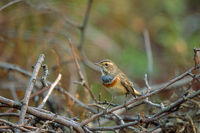|
Luscinia |

Bluethroat (Luscinia svecica)
|
|
Scientific classification |
|
|
| Species |
|
See text. |
Luscinia is a genus of small
passerine
birds formerly classed as members of the
thrush family, but now considered to be
Old World flycatchers.
The species are:
- Bluethroat, Luscinia svecica
Siberian Rubythroat, Luscinia calliope
Rufous-tailed Robin or Swinhoe's Nightingale, Luscinia
sibilans
Thrush Nightingale, Luscinia luscinia
Nightingale, Luscinia megarhynchos
Indian Bluechat, Luscinia brunneus
White-tailed Rubythroat, Luscinia pectoralis
Rufous-headed Robin, Luscinia ruficeps
Black-throated Blue Robin, Luscinia obscura
Firethroat, Luscinia pectardens
Siberian Blue Robin, Luscinia cyane
Formerly, some or all of the Luscinia species have
been placed in the genus Erithacus and vice versa. Recent
research (Seki, 2006) suggests that the genus should be
split, with most species being retained in Luscinia and a
new genus uniting East Asian forms like the Siberian Blue Robin with the
East Asian Erithacus species.
These are species of the temperate regions of Europe and
Asia, including the Himalayas. All the birds in this genus are strongly
migratory, wintering in tropical
Africa, India or Southeast Asia.
The breeding habitat is typically scrub or forest, and
the cup nest is usually constructed low in a bush. The birds
can be difficult to see in dense undergrowth, especially if
not singing, but they may frequent somewhat more open
habitats in their winter quarters.
The Luscinia species are stocky small birds, 13-16
cm long with an upright stance and short frequently cocked
tail. They are territorial birds which watch for
insects, worms and other invertebrates from a low perch, and feed mostly on the
ground, hopping on strong legs with frequent stops.
In the three species named as nightingales, the sexes are
similar. These birds are plain brown above, whitish below
with light streaking, and have a rufous tail.
In the other Luscinia species, the male is much
brighter than the usually brown or grey female. Males of
most of these species have a dark blue or black back, and
red, orange or blue at least on the throat and upper breast.
Several have white or rufous patches on the sides of the
tail, giving a pattern recalling that of a
wheatear or
Red-breasted Flycatcher.
The songs of this genus are often complex and musical,
especially in the nightingales.
References
- Grimmett, Richard; Inskipp, Carol & Inskipp,
Tim (1999): Birds of India, Pakistan, Nepal,
Bangladesh, Bhutan, Sri Lanka, and the Maldives.
Princeton University Press, Princeton, N.J..
ISBN 0-691-04910-6
- Seki, Shin-Ichi (2006): The origin of the
East Asian Erithacus robin, Erithacus komadori,
inferred from cytochrome b sequence data.
Molecular Phylogenetics and Evolution 39(3):
899–905.
DOI:10.1016/j.ympev.2006.01.028
- Svensson, Lars; Zetterström, Dan; Mullarney,
Killian & Grant, P. J. (1999): Collins bird guide.
Harper & Collins, London.
ISBN 0-00-219728-6




